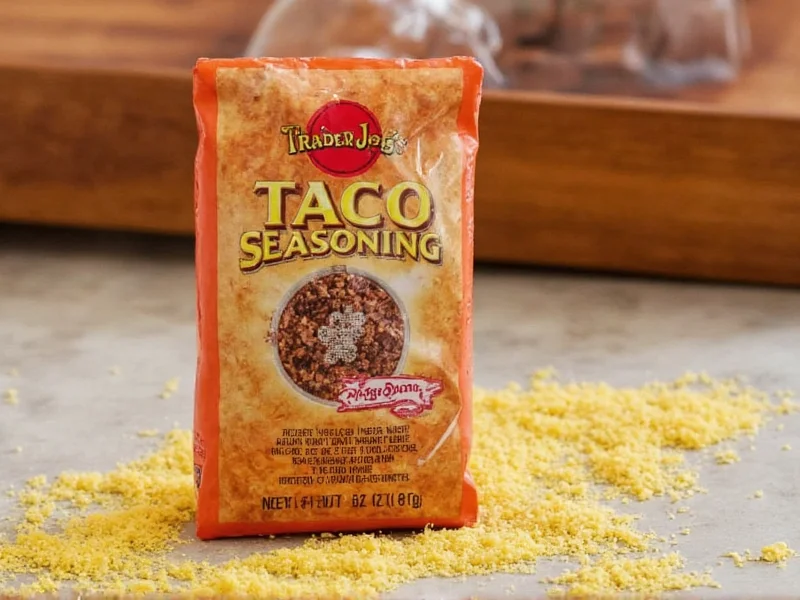For home cooks seeking convenience without compromising flavor, Trader Joe's taco seasoning has become a pantry staple. This single-serve packet system eliminates waste while delivering consistent results for taco night. Understanding exactly what goes into this popular product helps consumers make informed choices about their meal preparation.
Breaking Down Trader Joe's Taco Seasoning Ingredients
Unlike many commercial taco seasoning blends that rely on fillers and anti-caking agents, Trader Joe's version maintains a remarkably clean ingredient list. Each packet contains:
- Chili pepper (provides base heat)
- Paprika (adds depth and color)
- Cumin (earthy backbone flavor)
- Garlic powder (savory complexity)
- Onion powder (sweet aromatic notes)
- Oregano (herbal finish)
- Salt (flavor enhancer)
Notably absent are common additives like cornstarch, maltodextrin, or silicon dioxide that many national brands use as anti-caking agents. This cleaner formulation contributes to the seasoning's ability to create a richer, less pasty sauce when combined with meat and liquid.
Flavor Profile Analysis
Trader Joe's taco seasoning delivers a medium heat level that most palates find approachable. The cumin takes center stage, supported by earthy paprika and subtle chili heat. Unlike some commercial blends that emphasize saltiness, this version balances seasoning elements to enhance rather than overwhelm the meat.
Food scientists note that the absence of fillers allows the spices to bloom more effectively when cooked. When prepared according to package directions (adding 1/3 cup water to the seasoning and meat mixture), the resulting sauce coats proteins beautifully without becoming gloppy—a common issue with starch-heavy commercial blends.
Nutritional Comparison
| Brand | Serving Size | Sodium (mg) | Calories | Key Additives |
|---|---|---|---|---|
| Trader Joe's | 1.1 oz packet | 650 | 30 | None |
| McCormick | 1 oz packet | 730 | 25 | Cornstarch, silicon dioxide |
| Old El Paso | 1.25 oz packet | 800 | 35 | Maltodextrin, corn starch |
| Homemade blend | 2 tbsp | 400 | 15 | None |
This nutritional comparison reveals Trader Joe's advantage in formulation purity, though sodium content remains similar to competitors. The absence of fillers means the seasoning delivers more actual spice per ounce compared to starch-laden alternatives.
Practical Usage Recommendations
While the package instructions suggest using one packet with 1 pound of ground meat and 1/3 cup water, experienced home cooks have discovered several optimization techniques:
- For richer flavor: Bloom the seasoning in 1 tablespoon of oil before adding meat
- To reduce sodium: Use only 3/4 of the packet and add extra spices
- For authentic texture: Simmer meat mixture covered for 5 minutes after adding water
- Versatile applications: Works equally well with ground turkey, chicken, or plant-based proteins
Many users report success using Trader Joe's taco seasoning beyond traditional tacos—incorporating it into taco salads, taco soup, and even as a seasoning for roasted vegetables. The single-serve format prevents the waste common with larger containers that lose potency before finishing.
Trader Joe's vs. Homemade Taco Seasoning
When comparing Trader Joe's offering to homemade versions, several factors come into play:
Convenience factor: The single-serve packet requires zero measuring and eliminates spice cabinet clutter. For busy weeknight meals, this convenience often outweighs marginal cost savings of homemade blends.
Flavor consistency: Commercial blends like Trader Joe's provide reliable results batch after batch, whereas homemade versions can vary based on spice freshness and measurement accuracy.
Cost analysis: At approximately $1.49 per packet (enough for 1 pound of meat), Trader Joe's seasoning costs about $0.14 per ounce. A homemade blend using bulk spices costs roughly $0.08 per ounce but requires initial investment in multiple spice containers that may go unused.
Storage and Shelf Life Considerations
As a single-serve product, Trader Joe's taco seasoning avoids the primary issue with larger containers—spice degradation. Most commercial spice blends lose potency within 6 months of opening, but the sealed packet ensures maximum freshness through the printed expiration date.
For those who purchase multiple packets, store them in a cool, dark place away from heat sources. The individual foil wrapping provides excellent protection against moisture and light, preserving flavor compounds longer than traditional shaker containers.
Addressing Common Consumer Questions
Based on extensive user feedback and product analysis, certain questions arise repeatedly about this popular seasoning mix. Understanding these concerns helps consumers make informed decisions about incorporating it into their cooking routine.











 浙公网安备
33010002000092号
浙公网安备
33010002000092号 浙B2-20120091-4
浙B2-20120091-4